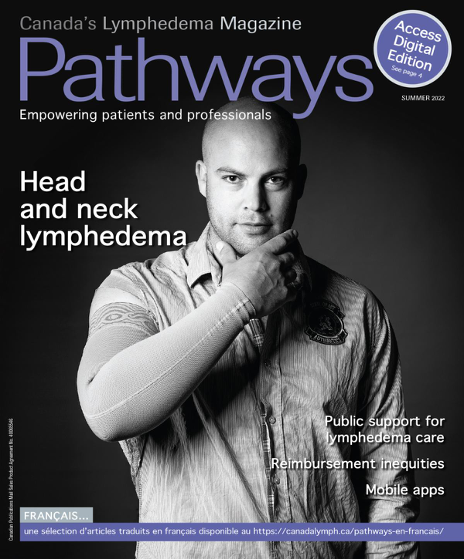Assessment of head and neck lymphedema by Marize Ibrahim
Originally published in Pathways, (Summer, 2022). Copyright (2022), Canadian Lymphedema Framework. Reprinted with permission.

The World Health Organization estimates the incidence of head and neck cancers (HNC) worldwide is more than 550,000. Head and neck lymphedema (HNL) is a significant and commonly neglected side effect that unfortunately remains underdiagnosed and understudies.
Marize Ibrahim is a Physical Therapist and lymphedema therapist working at the McGill Univeristy Hospital Center Lymphedema Clinic 9Montreal, Canada). In her article she focuses on the issue of assessment and diagnosis.
References:
- WHO Expert Committee on the Selection, Use of Essential Medicines, & World Health Organization. (2014). The Selection and Use of Essential Medicines: Report of the WHO Expert Committee, 2013 (including the 18th WHO Model List of Essential Medicines and the 4th WHO Model List of Essential Medicines for Children) (Vol. 985). World Health Organization.
- Canadian Cancer Statistics Advisory Committee in collaboration with the Canadian Cancer Society, S.C.a.t.P.H.A.o.C. Canadian Cancer Statistics 2021. Toronto, ON: Canadian Cancer Society (2021).
- Kreimer, A, Clifford G, Boyle P, Franceschi S. Human papillomavirus types in head and neck squamous cell carcinomas worldwide: A systematic review. Cancer Epidemiol Biomarkers Prev 2005, 14:467-475
- Jeans, C., Brown, B., Ward, E. C., Vertigan, A. E., Pigott, A. E., Nixon, J. L., & Wratten, C. (2020). Comparing the prevalence, location, and severity of head and neck lymphedema after postoperative radiotherapy for oral cavity cancers and definitive chemoradiotherapy for oropharyngeal, laryngeal, and hypopharyngeal cancers. Head & neck, 42(11), 3364-3374.
- Pfister, D. G., Spencer, S., Adelstein, D., Adkins, D., Anzai, Y., Brizel, D. M., … & Darlow, S. D. (2020). Head and neck cancers, version 2.2020, NCCN clinical practice guidelines in oncology. Journal of the National Comprehensive Cancer Network, 18(7), 873-898.
- Jeans, C., Brown, B., Ward, E.C. & Vertigan, A.E. Lymphoedema after head and neck cancer treatment: an overview for clinical practice. British journal of community nursing 26, S24-S29 (2021).
- Cohen, E. E., LaMonte, S. J., Erb, N. L., Beckman, K. L., Sadeghi, N., Hutcheson, K. A., … & Pratt‐ Chapman, M. L. (2016). American Cancer Society head and neck cancer survivorship care guideline. CA: a cancer journal for clinicians, 66(3), 203-239.
- Anand, A., et al. Secondary lymphedema after head and neck cancer therapy: a review. Lymphology 51, 109-118 (2018).
- Deng, J., et al. Prevalence of secondary lymphedema in patients with head and neck cancer. Journal of pain and symptom management 43, 244-252 (2012).
- Smith, B. G., Hutcheson, K. A., Little, L. G., Skoracki, R. J., Rosenthal, D. I., Lai, S. Y., & Lewin, J. S. (2015). Lymphedema outcomes in patients with head and neck cancer. Otolaryngology–Head and Neck Surgery, 152(2), 284-291.
- Starmer, H. M., Drinnan, M., Bhabra, M., Watson, L. J., & Patterson, J. (2021). Development and reliability of the revised Patterson Edema Scale. Clinical Otolaryngology, 46(4), 752-757.
- Smith, B. G., & Lewin, J. S. (2010). The role of lymphedema management in head and neck cancer. Current opinion in otolaryngology & head and neck surgery, 18(3), 153.




